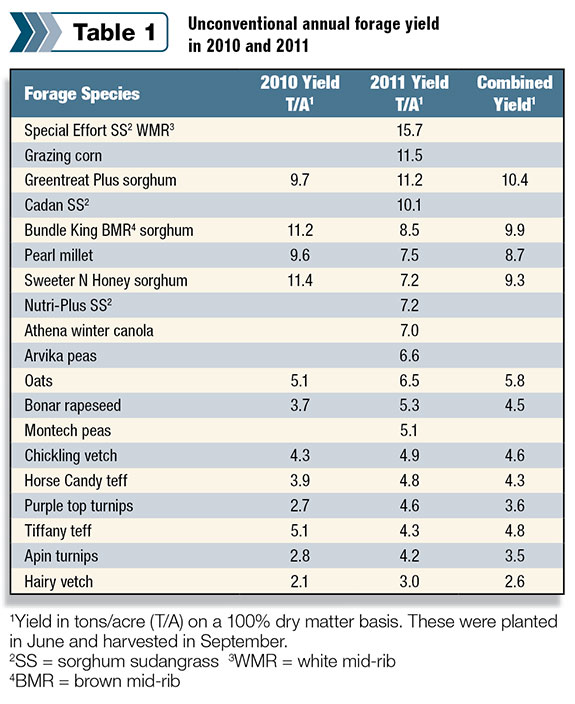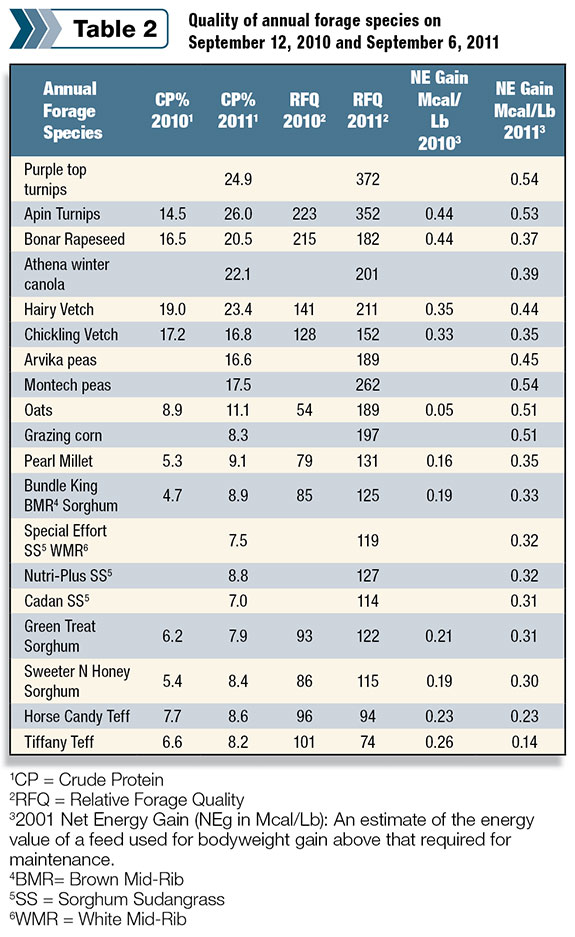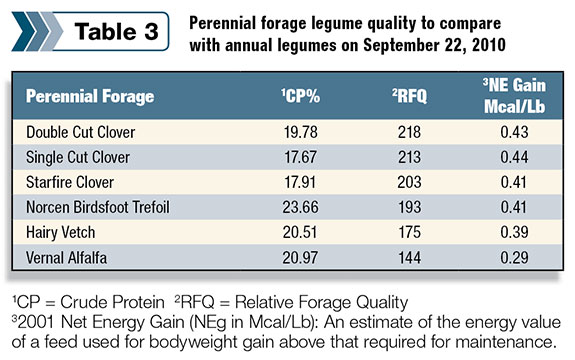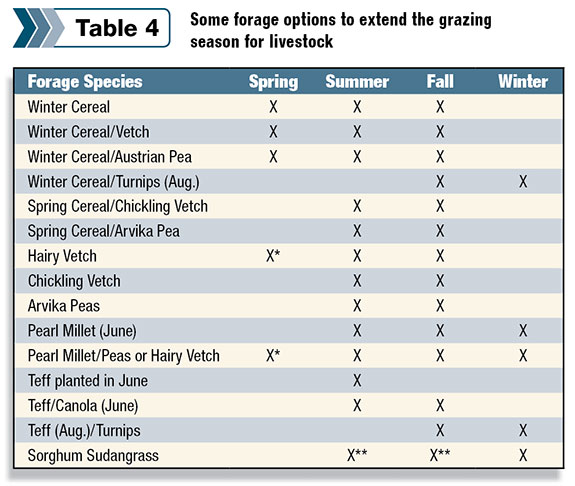Annual forages can be used to reduce feed costs by extending the grazing season, as the primary harvested feed, as a rotation crop between alfalfa, as a double crop with cereal grains, as a green manure for nutrients or as a cover crop for erosion or weed control. The right forage specie depends on individual objectives and conditions.
This article focuses on irrigated forage yield and quality of warm-season annuals, legumes and forage combinations in southern Idaho and their potential for extending the livestock grazing season in areas with similar growing conditions.
Data from replicated research trials is presented, with additional management practices included from on-farm/ranch trials.
Warm-season annuals
Sorghum, sorghum sudangrass hybrids (SS), pearl millet (PM) and teff provide options for low-cost rotational forages between stands of alfalfa or pasture, as hay or to stockpile for extending the grazing season.
Planted after all danger of frost is past, these warm-season forages grow well during the hot summer months. Sorghum sudangrass grows fast and is able to compete well against weeds.
Some of these produced more biomass than alfalfa, even though they had a shorter growing season and required less irrigation.

The sorghum, SS and PM yielded 7.2 to 15.7 tons per acre (T/A) (Table 1).
These forage yields were achieved with only 50 to 80 lbs nitrogen per acre and less irrigation than corn silage due to the later planting.
Each had good yields and acceptable quality when stockpiled for fall grazing. In 2011, the PM, SS and sorghum ranged from 0.30 to 0.35 Mcal per lb net energy for livestock gain and had relative forage quality (RFQ) values ranging from 114 to 131 (Table 2). RFQ is an index that replaces RFV (relative feed value).
On-farm trials show using teff for summer grazing (July to August) is a good fit.
It can fill the forage gap when cool-season grass growth slows due to hot weather and allow perennial pastures to re-grow.
Stockpiling teff until September resulted in lower-quality forage (RFQ values of 74 to 101, Table 2).

Teff yields (3.9 to 5.1 T/A, Table 1) were much lower than PM. Pearl millet can be used for summer, fall or winter grazing (stays standing up in snow).
When stockpiling the PM for fall or winter grazing, the yield was 7.5 to 9.6 T/A (Table 1). The RFQ values fluctuated from 131 in 2011 to 79 in 2010 (Table 2).
Harvest was done in early to mid-September both years, but the plants were more mature in 2010, so the forage quality was lower that year.
During on-farm trials with PM and teff, the highest forage quality was obtained during the vegetative stage.
Careful attention to repeat grazing when forage quality is high will result in the greatest benefit for livestock weight gain during the summer and early fall.
Teff and PM can both be grazed during the summer with minimal concerns for nitrate or prussic acid.
Legumes
Legumes (hairy and chickling vetches, peas) resulted in high forage quality (Table 2).
In September, hairy vetch RFQ values ranged from 141 to 211 and CP (crude protein) from 19 to 23 percent.
Chickling vetch had RFQ values of 128 to 152 and CP of 17 percent.
Chickling vetch (AC Greenfix) was understood to survive until frost; however, it and Arvika forage peas have survived repeat times of 19 degrees F in on-farm trials.
Hairy vetch can survive the winter, which is beneficial for forage production but not for fields going back into crop production.
In on-farm trials, the vetch has been grazed individually or mixed with other forages. Hairy vetch has a low bloat potential. Peas had high forage quality, with RFQ values of 189 to 262 and 16.6 to 17.5 percent CP. Since the peas are higher quality, they should be mixed with higher-fiber forage for grazing livestock.

Forage combinations
Peas, turnips and canola (rapeseed) were evaluated individually and in September had higher forage quality in comparison to perennial forage legumes (Table 2 and Table 3).
The RFQ values were higher than premium-quality alfalfa.
Since the quality of these forages is so high, and the fiber content so low, combinations with lower-quality, high-fiber forages could be beneficial.
For example, one farm/ranch planted turnips in August, then strip grazed them with stockpiled perennial tall fescue pasture to provide a high-quality forage for late fall/early winter grazing.
Other high-fiber options to mix with peas, turnips or canola include teff, PM or cereal forages.
Instead of combining different forage species in the same field, another option is to grow vetch, turnips or rapeseed adjacent to a field of perennial pasture, cereals or pearl millet, and then set up the electric fencing so the livestock strip graze both fields at once.
Cautions
Nitrate and prussic acid can both be lethal to livestock. Generally, when plants receive high nitrogen rates, or are stressed, they accumulate more nitrates.
So obtaining lab nitrate analysis, especially on new forages you are not familiar with, is a good safety precaution.
Both prussic acid and nitrate content should be monitored when grazing sorghum or SS during the summer, and during or right after frost. More information on prussic acid management can be found, click here to view.

Summary
Winter cereals provide high-quality, good yielding forages in the spring and fair-quality, low-cost re-growth in July.
Using PM or SS provides an opportunity to produce a large quantity of fair-quality forage for grazing in the fall/winter.
Teff can be used for summer grazing. Turnips, peas, rapeseed (canola) and vetch provide higher-quality forage but a lower yield than PM or SS.
Canola and turnips should not be fed alone, since they are too high of a quality.
Each operation is unique, so Table 4 is provided to help you determine which forage specie or species combination will maximize the grazing potential of your forages. ![]()
Shewmaker is an extension forage specialist with the University of Idaho. Falen is a Lincoln County extension educator with the University of Idaho.







